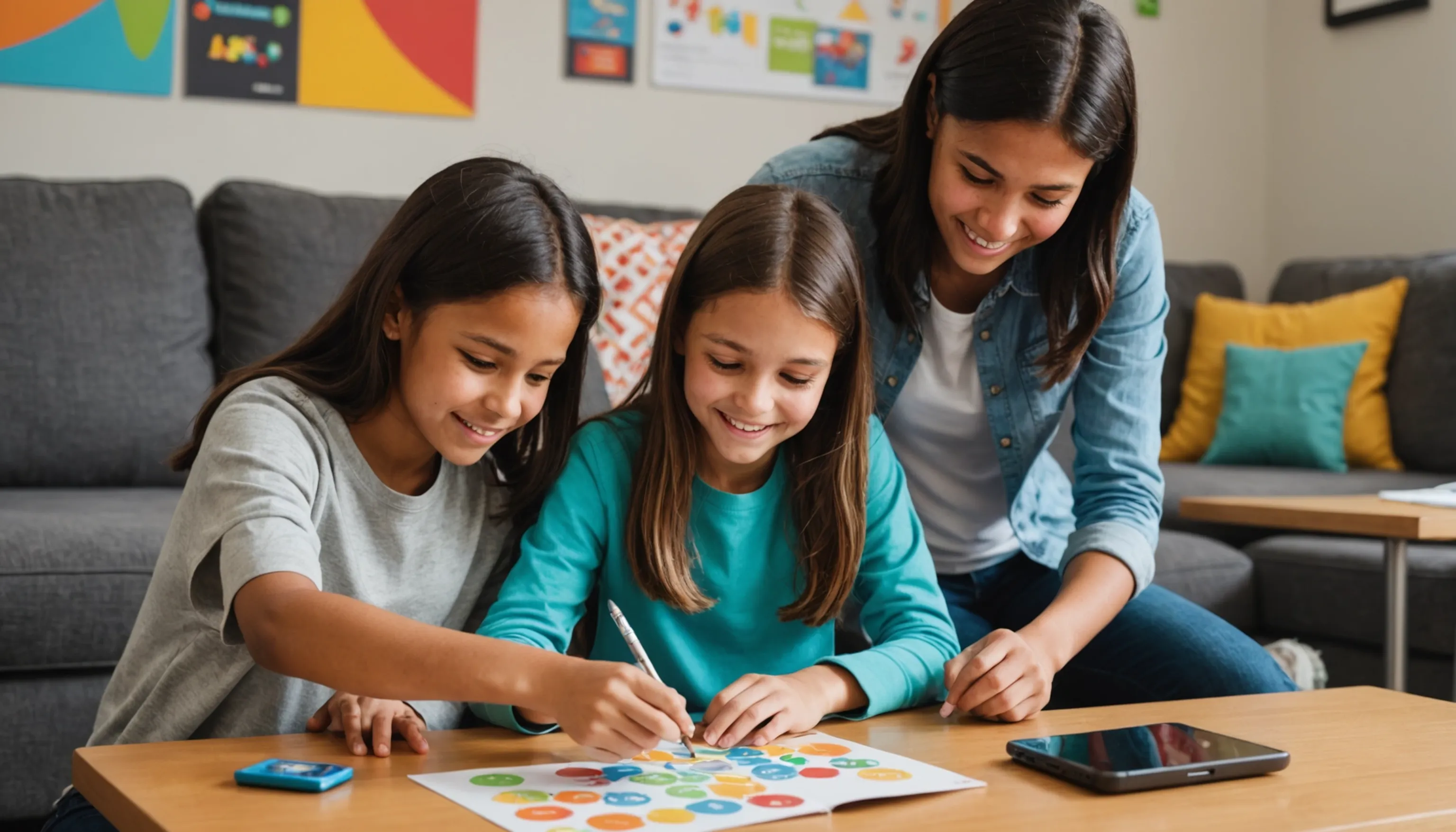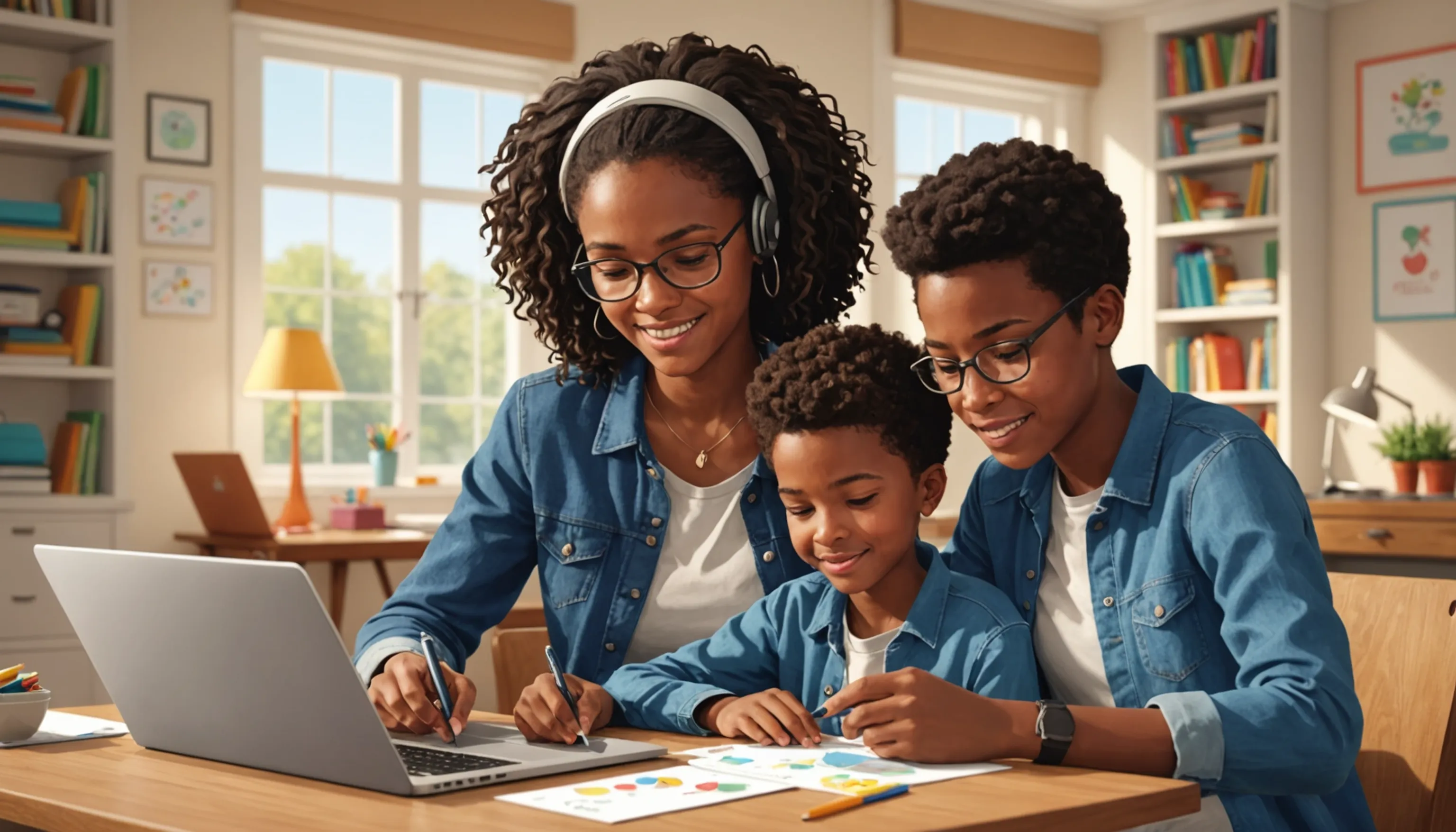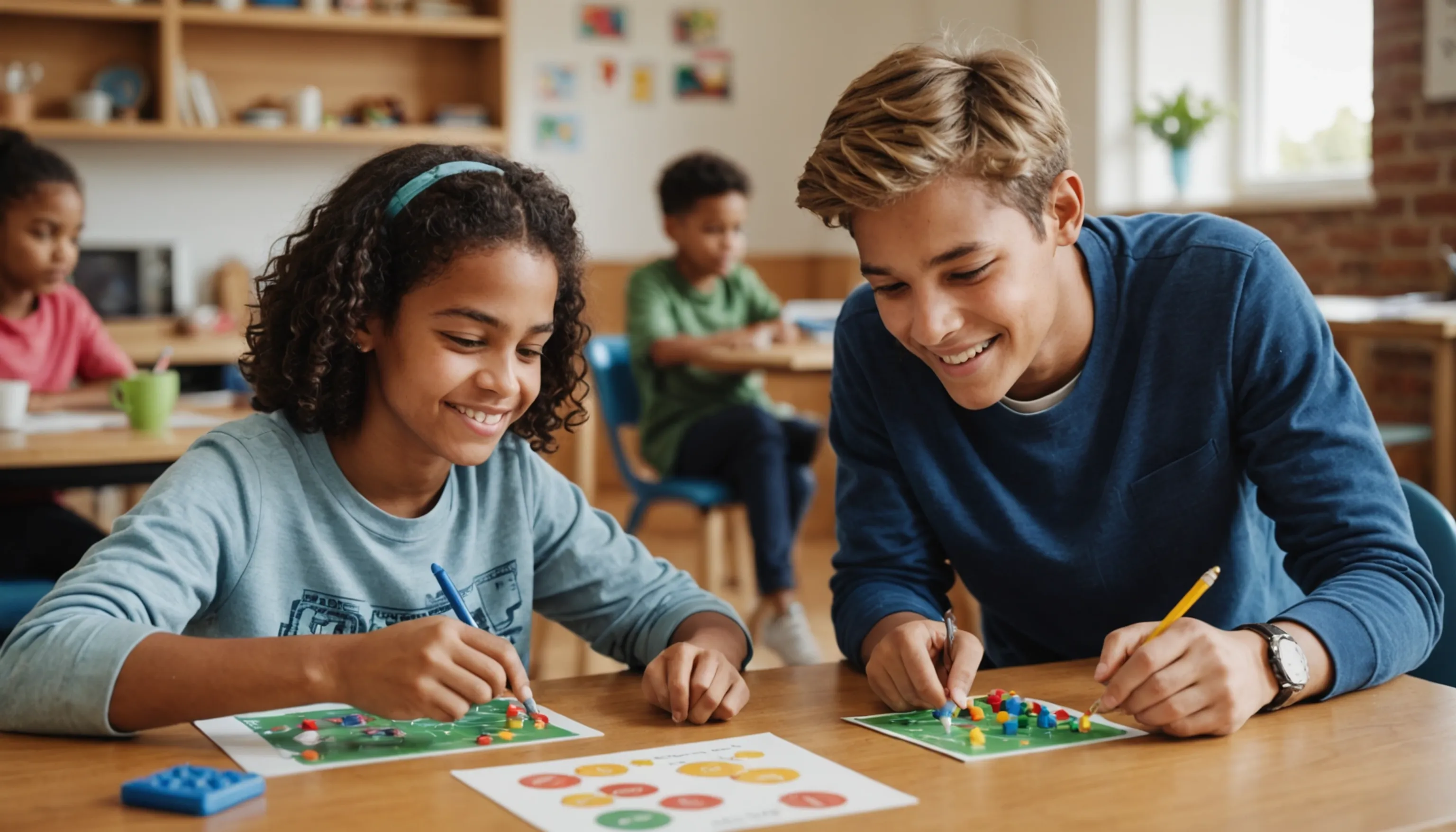How Gamified Learning Helps Parents
 HvWHenry van Wagenberg
HvWHenry van Wagenberg
How Gamified Learning Benefits Parents and Teens
Gamified learning offers significant benefits for both parents and teens, transforming the educational experience into an engaging and interactive journey. By integrating game elements into the learning process, it captivates teens' attention and encourages them to take an active role in their education.
This approach not only makes learning more enjoyable but also helps parents foster a deeper connection with their teens. As parents observe their children engaging with learning materials, they can support their academic journey more effectively. Ultimately, gamified learning creates a win-win situation, enriching the educational experience for both parties.
Understanding Gamified Learning
Gamified learning is an innovative educational approach that incorporates game design elements into traditional learning environments. This method leverages the principles of game mechanics, such as points, badges, leaderboards, and challenges, to enhance the learning experience. By transforming mundane tasks into engaging activities, gamified learning aims to increase motivation and participation among students, particularly teenagers.
At its core, gamified learning focuses on creating an immersive environment where students can explore and learn at their own pace. It encourages a sense of accomplishment as learners progress through levels or earn rewards for completing tasks. This not only boosts their confidence but also fosters a positive attitude towards learning.
Understanding gamified learning also involves recognizing its potential to cater to various learning styles. Some teens may thrive in competitive settings, while others may prefer collaborative environments. Gamified learning can be tailored to accommodate these preferences, making it more effective for diverse learners.
Moreover, this approach promotes essential skills that are vital for teen development. As students engage in gamified tasks, they enhance their critical thinking, problem-solving abilities, and social skills through collaborative learning activities. Overall, gamified learning represents a shift in educational practices, focusing on making learning enjoyable while still achieving academic goals. Parents and educators who embrace this method can facilitate a more engaging and effective learning journey for teens.
The Importance of Engagement in Learning
Engagement is a crucial element in the learning process, especially for teenagers who are navigating the complexities of education. When students are engaged, they are more likely to absorb information, retain knowledge, and develop a genuine interest in the subject matter. This is where gamified learning shines, as it transforms traditional learning into an interactive experience that captivates students' attention.
When teens are actively involved in their learning, they tend to experience higher motivation levels. This increased motivation often leads to a greater willingness to tackle challenging subjects, explore new ideas, and participate in discussions. In contrast, disengaged students may struggle to focus, leading to poor academic performance and a lack of enthusiasm for learning.
Furthermore, engagement fosters a sense of ownership over the learning process. When students feel responsible for their education, they are more likely to set personal goals and strive to achieve them. Gamified learning enhances this sense of ownership by allowing teens to progress through levels, earn rewards, and track their achievements in real-time.
Additionally, engaged learners are more likely to develop critical thinking and problem-solving skills. Gamified elements often present challenges that require students to think creatively and collaboratively. This not only aids in academic success but also prepares them for real-world situations where these skills are essential.
In summary, engagement is vital in learning, especially for teens. By incorporating gamified learning techniques, parents and educators can create an environment that fosters excitement, motivation, and success.

Benefits of Gamified Learning for Parents
Gamified learning offers numerous benefits for parents, enhancing their involvement in their teens' education. First, it fosters improved communication between parents and teens, as engaging learning experiences often spark discussions about progress and challenges. Parents can easily track their child's progress through gamified platforms, allowing for timely support and encouragement. This visibility helps parents understand their child's strengths and areas for improvement.
Moreover, gamified learning creates a more positive learning environment, reducing homework-related stress. Overall, parents gain the tools to nurture their child's educational journey, leading to better academic outcomes.
Improved Communication with Teens
Improved communication between parents and teens is one of the standout benefits of gamified learning. This educational approach not only makes learning more enjoyable for teenagers but also creates opportunities for parents to engage in meaningful conversations about their child's educational journey. When teens participate in gamified learning activities, they often become excited about their progress and achievements, which provides a natural opening for dialogue.
Parents can ask questions about the games or activities their teens are involved in, fostering an interest in their educational experiences. This encourages teens to share their thoughts and feelings, resulting in a more open and trusting relationship. For instance, when parents inquire about the challenges their teens face in a gamified setting, it can lead to discussions about problem-solving strategies and coping mechanisms, which are valuable life skills.
Moreover, gamified learning platforms typically provide parents with insights into their child’s progress and performance. This real-time feedback enables parents to celebrate successes and address areas needing improvement. By participating in the learning process together, parents can offer support in a way that resonates with their teens, making discussions about education less intimidating and more collaborative.
In summary, gamified learning not only enhances educational outcomes but also strengthens the parent-teen relationship through improved communication. This collaborative approach empowers both parties, creating a supportive environment that fosters academic success and personal growth.
Easier Tracking of Progress
Easier tracking of progress is a significant advantage of gamified learning for both parents and teens. Traditional education often lacks transparency, making it challenging for parents to understand their child's academic journey. However, gamified learning platforms typically provide real-time data on student performance, allowing parents to monitor their child's progress effortlessly.
These platforms often feature dashboards that display various metrics, such as completed tasks, earned points, and level achievements. Such visual representations make it simple for parents to see where their teens excel and where they may need additional support. This immediate feedback loop encourages timely discussions about academic challenges and successes, fostering a proactive approach to education.
Additionally, tracking progress in a gamified setting often motivates teens to take ownership of their learning. As they see their achievements quantified through points or badges, they are likely to set personal goals and strive for continuous improvement. This self-directed learning not only boosts their confidence but also encourages a growth mindset.
For parents, this means they can engage in more meaningful conversations about their child's education, discussing strategies to overcome obstacles or celebrating milestones together. Ultimately, the ease of tracking progress through gamified learning platforms strengthens the parent-teen relationship and enhances the overall educational experience.
In conclusion, gamified learning simplifies progress tracking, empowering both parents and teens to work together toward achieving academic success.

Encouraging a Positive Learning Environment
Encouraging a positive learning environment is one of the key benefits of gamified learning, significantly impacting both teens and their parents. Traditional educational settings can sometimes feel rigid and stressful, leading to anxiety and disengagement among students. In contrast, gamified learning transforms the educational experience into an interactive and enjoyable journey, fostering a supportive atmosphere where teens feel safe to explore and learn.
By integrating game mechanics, such as rewards, challenges, and friendly competition, gamified learning motivates students to actively participate in their education. This engagement not only makes learning enjoyable but also reduces negative feelings associated with failure or low performance. Instead of viewing mistakes as setbacks, students learn to see them as opportunities for growth, enhancing their resilience and adaptability.
For parents, witnessing their teens thrive in a positive learning environment can be incredibly reassuring. They can observe their children developing a passion for learning and a willingness to take risks, knowing that the gamified approach encourages experimentation without fear of harsh judgment. This supportive environment also nurtures essential social skills, as students often collaborate with peers, learning to communicate effectively and work as part of a team.
Moreover, parents can reinforce this positive learning environment at home by celebrating achievements, both big and small. Recognizing their teen's progress in gamified learning not only boosts their confidence but also strengthens the parent-teen bond. In summary, gamified learning plays a crucial role in creating a positive educational experience that benefits both teens and their parents.
How Gamified Learning Supports Teen Development
Gamified learning plays a vital role in supporting teen development by fostering essential skills that prepare them for future challenges. By integrating game mechanics into the educational process, this approach encourages motivation, engagement, and a sense of achievement. Teens are more likely to participate actively in their learning when they see immediate rewards, such as points or badges.
Additionally, gamified learning promotes critical thinking and problem-solving abilities. Many gamified platforms present challenges that require students to strategize and collaborate with peers, enhancing their social skills and teamwork.
This interactive learning method also helps teens build resilience. As they navigate through various levels, they learn to cope with setbacks and embrace failures as part of the learning process. Overall, gamified learning not only enhances academic performance but also equips teens with vital skills for personal and professional growth.
Boosting Motivation and Interest
Boosting motivation and interest is a fundamental benefit of gamified learning, particularly for teenagers who often grapple with traditional educational methods. By incorporating game-like elements into the learning process, gamified learning transforms mundane tasks into engaging activities that capture students' attention. This shift not only makes learning more enjoyable but also instills a sense of excitement about acquiring new knowledge.
One of the key features of gamified learning is the use of rewards, such as points, badges, and levels, which serve as tangible indicators of progress. These rewards incentivize teens to push themselves further, fostering a growth mindset that encourages them to take on challenges rather than shy away from them. As students see their efforts recognized and rewarded, their intrinsic motivation to learn increases.
Additionally, gamified learning often incorporates elements of competition, whether against oneself or among peers. This friendly rivalry can spur students to strive for excellence, driving them to improve their performance and engage more deeply with the material. Furthermore, when teens are allowed to choose their learning paths or challenges, they develop a sense of ownership over their education, further fueling their interest.
In summary, gamified learning effectively boosts motivation and interest among teens by making education interactive and rewarding. By creating an engaging atmosphere, this approach not only enhances academic performance but also cultivates a lifelong love for learning.
Promoting Critical Thinking and Problem-Solving
Promoting critical thinking and problem-solving skills is a core benefit of gamified learning, making it particularly effective for teenagers. In traditional educational settings, students may often encounter rote memorization and passive learning, which can stifle their ability to think critically. However, gamified learning environments encourage students to engage actively with content, which fosters deeper understanding and analytical skills.
Gamified learning typically involves challenges and scenarios that require students to analyze information, weigh options, and make decisions. For instance, when faced with a problem in a game, teens must evaluate various strategies, consider potential outcomes, and adapt their approaches based on feedback. This process mirrors real-world situations where critical thinking and problem-solving are essential.
Moreover, many gamified platforms incorporate collaborative elements, allowing teens to work together to tackle challenges. This collaboration not only enhances their communication skills but also exposes them to diverse perspectives and ideas, enriching their problem-solving abilities. By discussing strategies and solutions with peers, students learn to approach problems from different angles, fostering creativity and innovation.
Additionally, the iterative nature of gamified learning enables students to fail safely and learn from their mistakes. This resilience-building aspect encourages teens to view challenges as opportunities for growth, further enhancing their critical thinking capabilities. In summary, gamified learning effectively promotes critical thinking and problem-solving skills, equipping teenagers with the tools they need to navigate complex situations in their academic and future professional lives.
Building Social Skills through Collaborative Learning
Building social skills through collaborative learning is one of the standout benefits of gamified learning, especially for teenagers navigating social dynamics. This interactive approach not only enhances academic performance but also fosters essential interpersonal skills that are crucial for personal and professional success. Here are some ways gamified learning promotes social skill development:
- Teamwork: Many gamified learning activities require students to work in teams to achieve common goals. This collaboration helps teens learn how to communicate effectively, delegate tasks, and support one another.
- Conflict Resolution: Working in groups can lead to disagreements. Gamified learning environments provide a safe space for teens to practice resolving conflicts, helping them develop negotiation and mediation skills.
- Empathy: Collaborative tasks often require students to consider the perspectives and strengths of their peers. This process fosters empathy, allowing teens to appreciate diverse viewpoints and backgrounds.
- Active Listening: To succeed in collaborative learning, teens must practice active listening. They learn to pay attention to others' ideas, which enhances their ability to process information and respond thoughtfully.
Furthermore, gamified learning encourages positive competition, where students cheer for each other's successes while also working towards their own. This environment nurtures camaraderie, reinforcing the idea that collaboration can lead to shared victories. Overall, gamified learning effectively builds social skills, preparing teenagers to thrive in both academic and social settings.
